1. Overview of 4EVERLAND
1.1 Project Introduction
1.1.1 Market Background
In recent years, the emergence of cloud computing has revolutionized traditional IT infrastructure. While centralized cloud computing has dominated the market, decentralized models are rapidly rising, redefining the game with greater freedom, security, and environmental sustainability. What are the key differences between centralized and decentralized cloud computing?

Compared to traditional centralized models, decentralized cloud computing excels with its flexibility and privacy features, positioning it as the future of the industry. Decentralized models don’t rely on a single super-server. Instead, data is distributed globally like water droplets across nodes, allowing for scalability and dynamic allocation, outperforming traditional cloud solutions.
Additionally, there is growing concern about the environmental impact of cryptocurrency systems, particularly energy-intensive Proof-of-Work (PoW) models. By 2025, data centers are expected to account for over 3% of global carbon emissions. By 2040, digital data storage could generate 14% of global carbon emissions, comparable to the current emissions of the United States.
This backdrop highlights the importance of DePIN (Decentralized Physical Infrastructure Networks), which spans key sectors like network infrastructure, energy sharing, edge computing, distributed computation, and decentralized storage. By leveraging blockchain and token incentives, DePIN transforms scattered resources into an efficiently operating network. Projects like Helium (wireless networks), DIMO (automotive IoT), Grass (data scraping platforms), and io.net (compute platforms) have demonstrated DePIN’s potential.
DePIN projects have attracted significant investments in recent years. Between Q3 2023 and Q3 2024, total funding in DePIN projects increased nearly sevenfold. In April 2023, Binance launched BNB Greenfield, a decentralized storage milestone. Greenfield provides core decentralized storage infrastructure for the BNB Chain ecosystem while enabling users and dApps to create, store, and trade fully autonomous data.
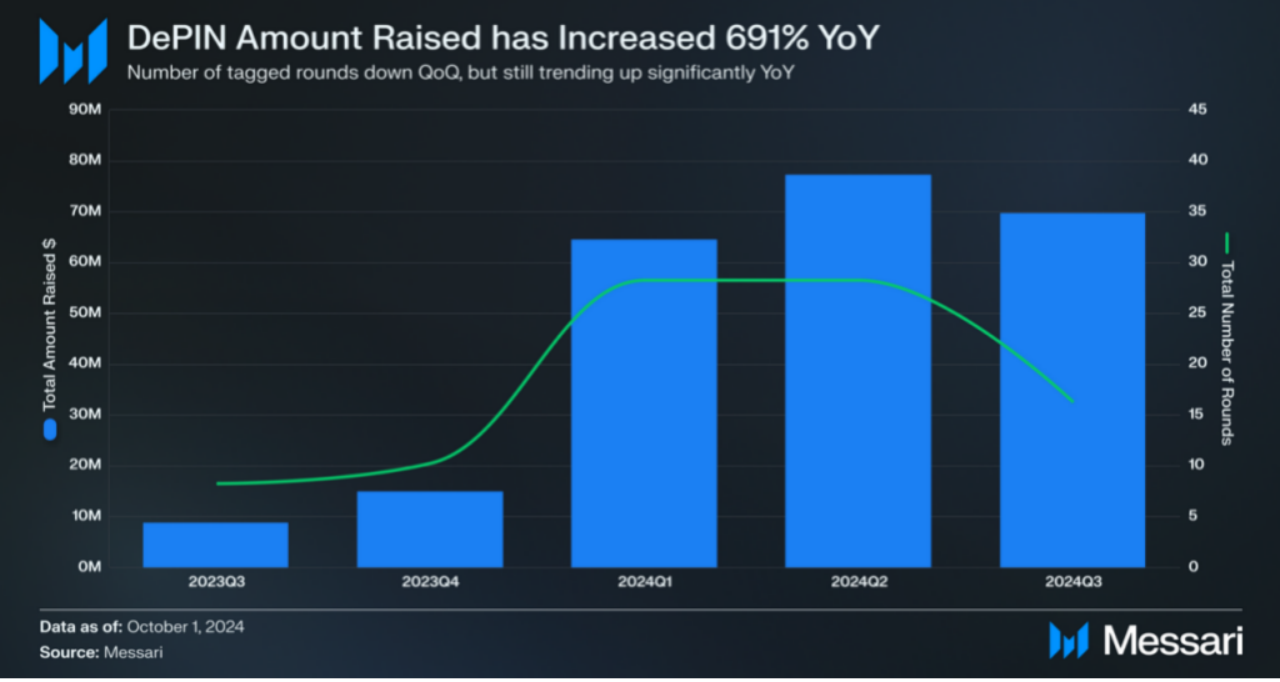
Currently valued at $90 billion, the DePIN industry sees 95% of its infrastructure capacity underutilized. Within this burgeoning space, 4EVERLAND is emerging as a rising star. It serves not only as a decentralized cloud computing platform but also as an aggregator of DePIN resources.
Unlike projects focusing on specific domains like Filecoin (storage) or io.net (computing), 4EVERLAND integrates multiple DePIN technologies, bundling Web3’s storage, computation, and network resources into tailored offerings for clients. For example, 4EVERLAND partners with decentralized storage leaders like Arweave, enabling efficient and seamless access to its storage services. The open-source voting platform Snapshot leverages 4EVERLAND’s solutions to store off-chain data on IPFS and Arweave, ensuring data verifiability and permanence.
By integrating decentralized physical infrastructure and idle community resources, 4EVERLAND aims to provide efficient, secure, and scalable cloud services, bridging Web2 and Web3 while empowering millions of Web3 developers and applications to transition smoothly to decentralized architectures.
1.1.2 Establishment and Development History
Founded in 2021 and headquartered in Singapore, 4EVERLAND has received investments from notable entities, including BIXIN, FENBUSHI, FBG, Mint Ventures, Arweave, and WaterDrip Capital.
As a next-generation decentralized cloud service platform, 4EVERLAND consolidates storage, network, and computing capabilities, delivering efficient, secure, and scalable cloud services through innovative architecture and resource integration. Positioned at the core of the DePIN ecosystem, its goal is to efficiently integrate decentralized physical resources and provide foundational infrastructure for millions of Web3 developers and applications.
4EVERLAND’s strategic focus includes two main areas:
-
Deep integration with existing DePIN protocols to maximize resource utilization efficiency.
-
Leveraging idle physical resources globally to significantly reduce operational costs. With these strategies, 4EVERLAND is building a robust and resilient decentralized cloud infrastructure, driving a new era of sustainable cloud computing. Additionally, 4EVERLAND plays a key role in the BNB Greenfield ecosystem and is recognized as a crucial player on Messari’s DePIN map, helping global developers transition seamlessly from Web2 to Web3 while igniting a decentralized cloud computing revolution.

1.1.3 Key Milestones
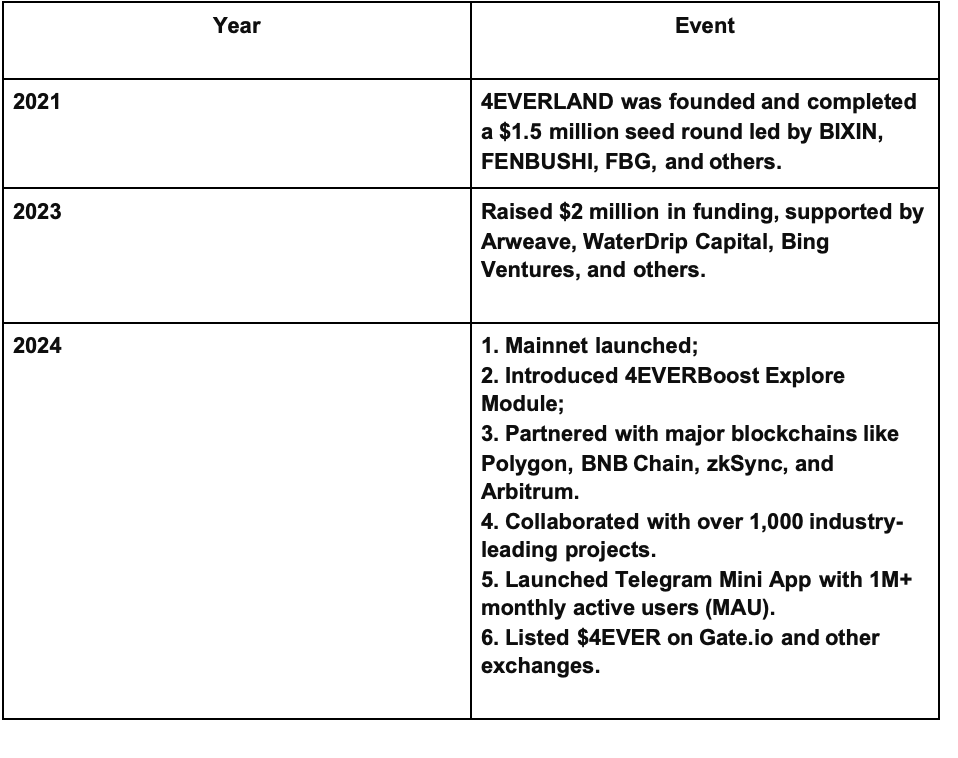
1.2 Data Overview
1.2.1 Project Statistics
Since the launch of its mainnet, 4EVERLAND has demonstrated rapid growth. Key statistics include:
• Registered Users: Over 3 million.
• Daily Active Users (DAU): Exceeding 100,000.
• Monthly Active Users (MAU): Surpassing 1 million.
• Developers and Clients: More than 250,000 globally.
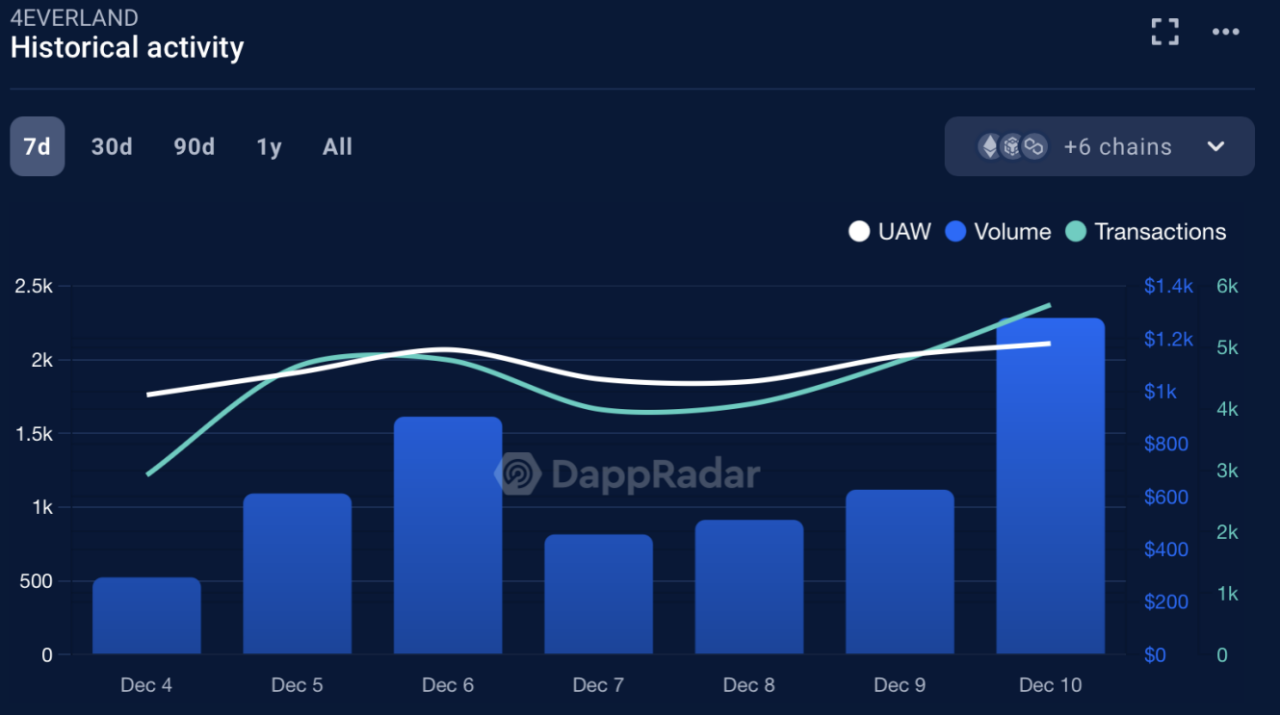
Recent data reveals a robust upward trend in key metrics such as unique active wallets (UAW) and transaction volume, reflecting 4EVERLAND’s increasing appeal among global developers and enterprises.
4EVERLAND has achieved a significant position in the decentralized storage market:
BNB Greenfield:
• 4EVERLAND is the largest decentralized storage provider within the Greenfield ecosystem.
• Officially certified as a Storage Provider (SP) and validator.
• Conducts 30,000+ daily storage transactions and recorded a 180% increase in transaction volume over the past week.
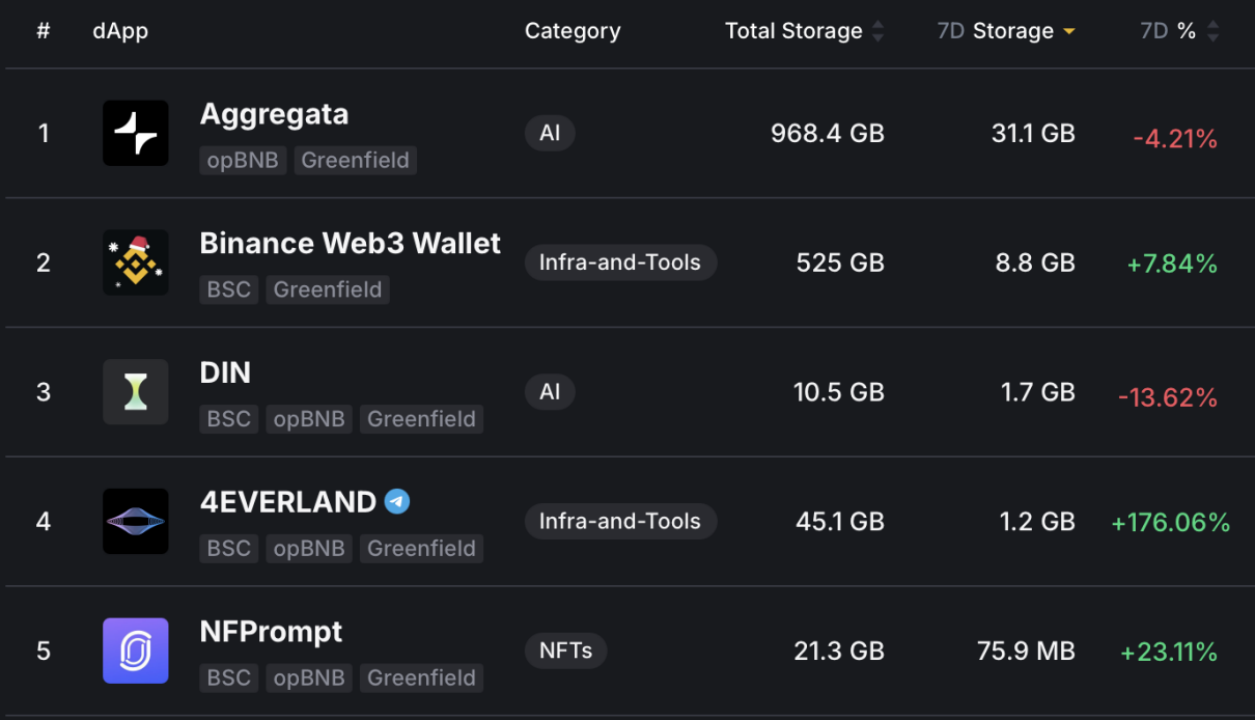
IPFS Storage:
• Total storage capacity: 2,000 TB.
• Ranked third in the IPFS ecosystem.
Arweave Storage:
• Achieved a total of 20 TB stored, securing third place in the Arweave ecosystem.
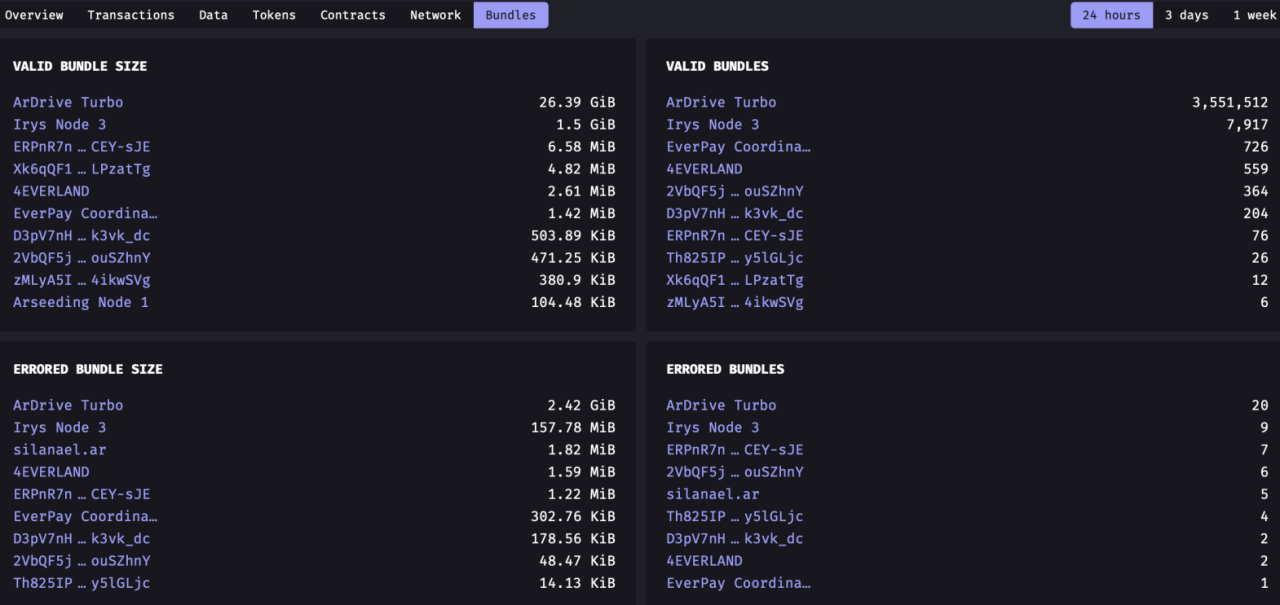
In terms of its core competitive advantages in serving global clients, 4EVERLAND has provided storage and computing services for over 250,000 applications. These include well-known projects such as Snapshot (the only provider of IPFS + Arweave storage and gateways), Taiko, PumpFun, Linear Finance, and RSS3.
Notably, 4EVERLAND’s support for Snapshot.org has positioned it as the top storage solution for developers and teams, outperforming competitors like Fleek and Pinata with a performance reliability of up to 99.9%. Additionally, 4EVERLAND has secured grants from BNBChain, Polygon, Optimism, IPFS, Arweave, and ICP, further solidifying its position as a leader in the decentralized cloud infrastructure space.
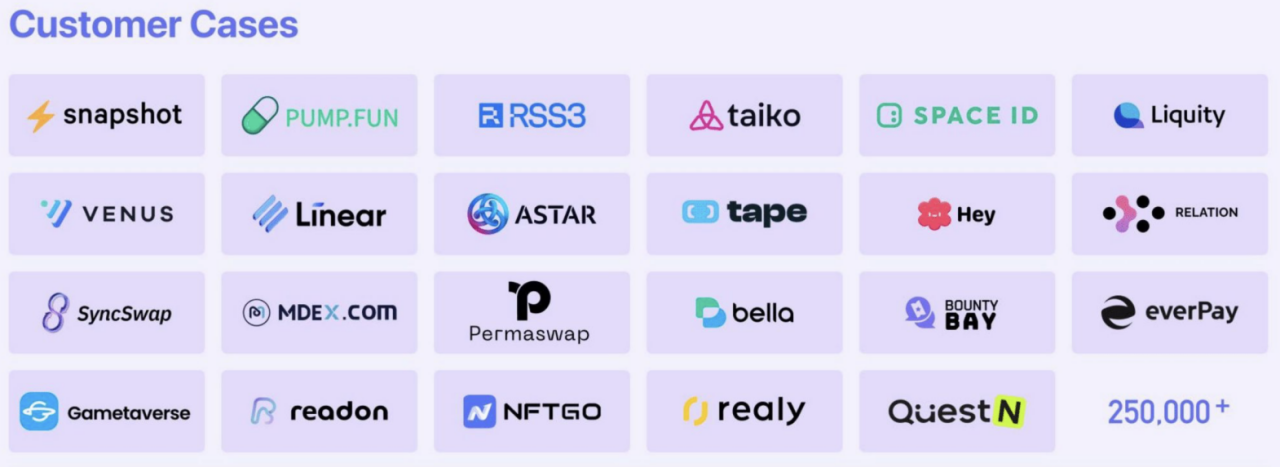
In terms of ecosystem support and wallet compatibility, 4EVERLAND is compatible with over 10 major Web3 wallets, including MetaMask, OKX Wallet, Binance Web3 Wallet, and Coinbase Wallet. This broad compatibility provides users and developers with convenient access and a wider range of application scenarios. This diverse support further reinforces 4EVERLAND’s central position in the Web3 ecosystem.
1.2.2 Social Media and Community Engagement
4EVERLAND maintains an active presence across various social media platforms:
• Telegram: Over 950,000 members, with 30,000+ active participants.
• X (formerly Twitter): 360,000 followers with frequent updates.
• Discord: Over 75,000 members, with more than 2,000 active participants.
• Telegram Mini App: Supports payments like Ton and Star and attracts 1M+ monthly active users.
Additionally, its GitHub sees over 30,000 daily interactions, driven by platform updates and user-hosted projects, further showcasing its vibrant developer ecosystem.
4EVERLAND’s impressive growth and active community involvement demonstrate its potential as a cornerstone in the Web3 cloud infrastructure space.
1.3 Tokenomics
The 4EVERLAND ecosystem is built around a dual-token economic model designed to ensure stability, security, and sustainable growth. The two tokens are $4EVER, the core governance token, and $LAND, the utility token for resource payments.
1.3.1 $LAND: Stable Utility Token for Resource Payments
$LAND serves as a stable token within the 4EVERLAND ecosystem, facilitating efficient resource payments.
• Stable Value Peg:
$LAND maintains a fixed exchange rate of 1 USD = 1 million $LAND, mitigating volatility risks for users.
• Resource Payments:
It is used to measure and settle all resource consumption on the platform, including bandwidth, build time, compute units, API calls, and node usage.
• Flexible Conversion Mechanism:
Users can convert multiple blockchain assets into $LAND, which are automatically converted to stablecoins and stored in a treasury smart contract.
• Treasury Circulation:
Assets stored in the treasury are allocated in two main ways:
1. Ecosystem Rewards: Used for $4EVER buybacks and distributed as rewards to resource providers and $4EVER holders.
2. Token Buyback and Burn: Reduces $4EVER token supply, increasing its scarcity and value.
• Non-Transferable:
$LAND is exclusively for resource payments within the 4EVERLAND ecosystem and is not tradable on secondary markets, ensuring price stability.
1.3.2 $4EVER: Governance and Utility Token
$4EVER is the core governance token of 4EVERLAND, acting as the foundation for ecosystem value and decentralized governance.
Key Features and Functions
1. Staking and Rewards:
• $4EVER powers the Proof-of-Stake (PoS) mechanism and AVS (Active Validation System)
• Resource providers must stake $4EVER to participate in node elections and receive staking rewards.
2. Value Capture and Buyback Mechanism:
• Revenue generated by the platform is partially allocated to the treasury.
• This revenue funds $4EVER buybacks and burns, enhancing its scarcity and value.
3. Resource Payments:
• Users can exchange $4EVER for $LAND to pay for services, promoting token circulation and demand.
4. Ecosystem Governance:
• $4EVER holders participate in decision-making, including platform upgrades, resource allocation, and shaping the ecosystem’s future through proposals and voting.
Token Distribution
The total supply of $4EVER is 10 billion tokens, allocated as follows:
• 40%: Node rewards
• 15%: Community development
• 10%: Operations
• 5%: User incentives
• 15%: Token sales
• 12%: Core team and advisors
• 3%: Initial liquidity and market-making
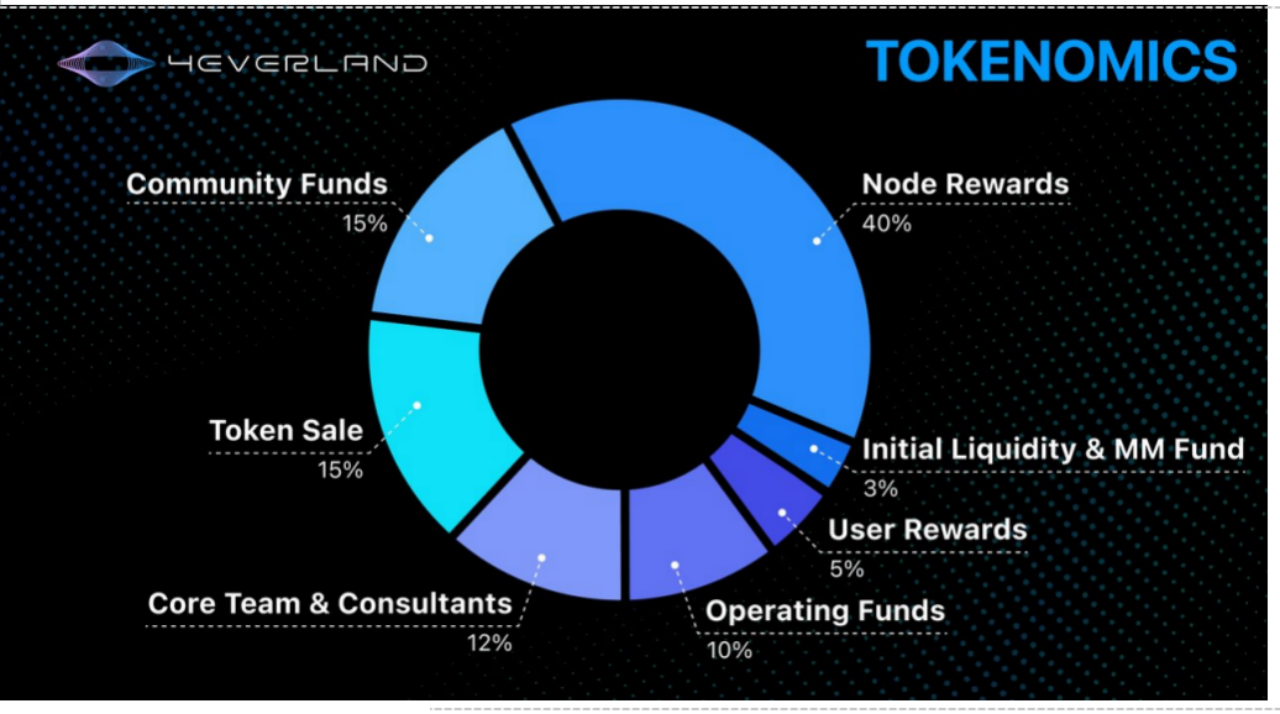
Economic Sustainability
4EVERLAND’s dual-token model ensures long-term ecosystem stability by balancing incentives for resource providers, users, and developers. The combination of resource-based $LAND and governance-focused $4EVER allows for both operational efficiency and dynamic community engagement.
In December 2024, $4EVER officially launched on major exchanges like Gate.io, further establishing its role in driving the decentralized cloud infrastructure of the Web3 ecosystem.
1.4 Technical Architecture Principles
4EVERLAND employs a decentralized ecosystem—4EVER Network—designed to dynamically allocate global resources, delivering seamless and reliable services for developers and users alike. Its architecture combines multiple decentralized technologies into a unified, highly scalable solution.
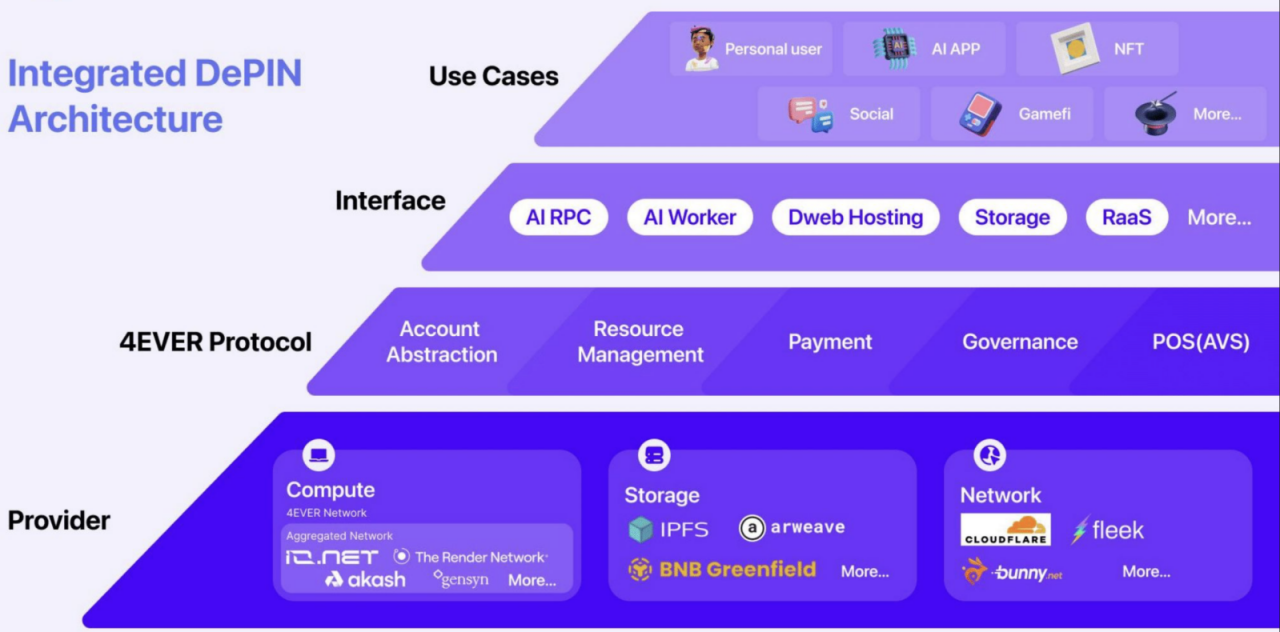
1.4.1 Core Architectural Elements
- 4EVER DePIN Aggregator
The 4EVER DePIN Aggregator serves as the cornerstone of the ecosystem, functioning like a universal tool to integrate decentralized infrastructure across various domains:
• Storage: Incorporates IPFS and Arweave for efficient, distributed storage solutions.
• Computation: Leverages platforms like Akash and IO.net for high-performance computing resources.
• Networking: Integrates services from Fleek and Cloudflare for enhanced networking capabilities.
This modular and “puzzle-like” design empowers developers to select and combine the most suitable services, akin to a buffet of decentralized tools.
- Resource Providers
Resource providers contribute computation, storage, or network capabilities by running integration software. The 4EVER Protocol orchestrates resource allocation based on user demand, ensuring tasks are efficiently distributed and providers are rewarded for their contributions.
- 4EVER Nodes
4EVER Nodes aggregate idle community hardware resources (e.g., storage, compute power, and bandwidth) into the ecosystem. Unlike traditional decentralized physical infrastructure networks (DePIN), these nodes virtualize contributed resources and integrate them directly into the network. This innovation enhances resource utilization, encourages community participation, and improves network flexibility and stability.
1.4.2 Operational Mechanics
4EVER Protocol
The protocol is the “rules engine” that governs resource operation and ensures security:
• Proof-of-Stake (PoS) Mechanism: Validates the credibility of resource providers using a staking and reward/punishment system.
• Token Incentives: Encourages resource sharing while maintaining network health.
• Modular Integration: Combines all resources into a unified interface for developers, simplifying operations and meeting diverse needs.
1.4.3 Advantages and Innovations
For Developers
1. Computation Providers:
Developers gain access to high-performance computing for tasks like machine learning, virtual reality, and video rendering through platforms like Akash and IO.net. This eliminates hardware limitations, enabling faster and more complex project execution.
2. Storage Providers:
With decentralized storage technologies (IPFS, Arweave, and BNB Greenfield), developers can store large datasets reliably. These solutions address single-point failures, ensure data retrieval efficiency, and are well-suited for applications like scientific research and content delivery networks.
3. Networking Providers:
By integrating networking solutions like Fleek, Meson Network, and Saturn, the platform offers stable connections and rapid data transfer. These benefits are critical for applications like live video streaming, online gaming, and IoT device management.
For Communities
4EVER Nodes create a “crowdsourced resource pool,” enabling individuals to contribute idle resources while earning rewards. This inclusive participation strengthens the ecosystem and broadens the availability of decentralized services.
1.4.4 Design Philosophy
The 4EVER Network can be described as a “smart, decentralized super cloud service provider.” It offers the following advantages:
1. Efficiency and Flexibility: A global network capable of scaling on demand and dynamically allocating resources.
2. Privacy and Security: A decentralized architecture protects data from centralized attacks while enhancing user privacy.
3. User-Centric Design: Simplified interfaces and tools reduce complexity, making it accessible for non-technical users to deploy decentralized applications (DApps).
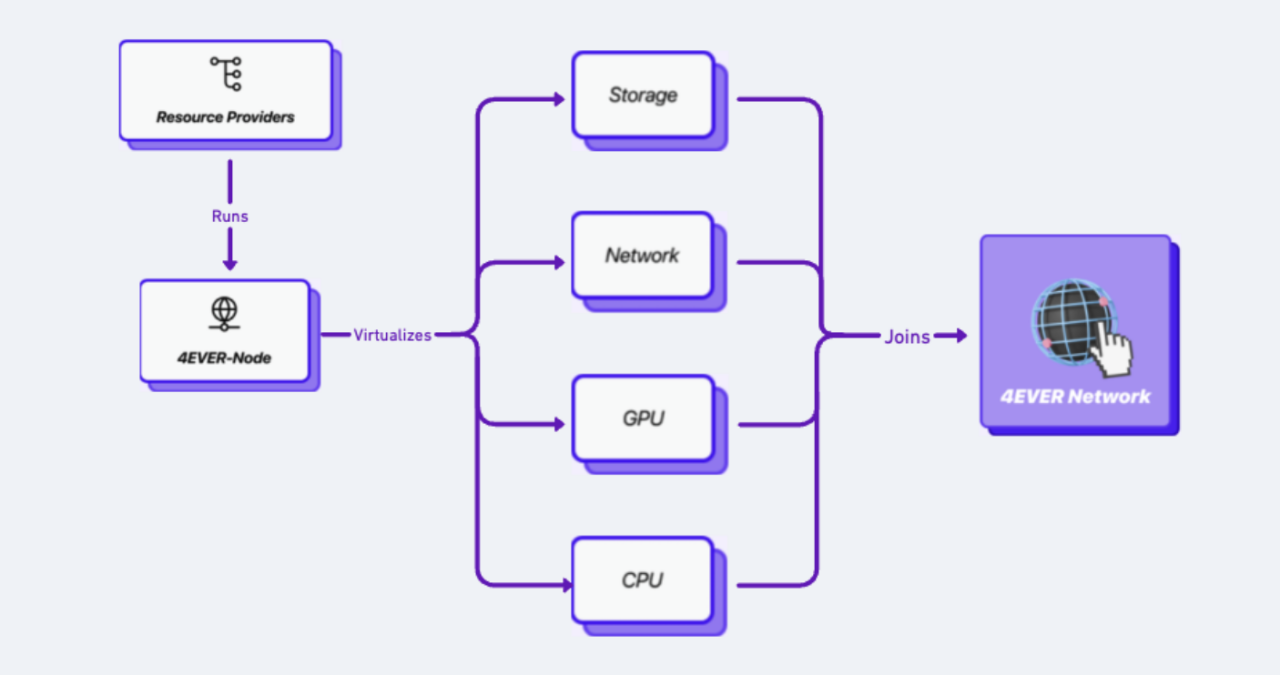
1.5 Competitors
The decentralized cloud computing space is competitive, with various players focusing on specific aspects of storage, computation, or networking. Below is a comparison of 4EVERLAND with its key competitors:
1.5.1 Filecoin
Overview:
Filecoin, developed by Protocol Labs, is a decentralized storage network enabling users to store and retrieve data securely using blockchain technology. It uses IPFS (InterPlanetary File System) for distributed file storage and is a market leader in Web3 storage.
Key Features:
• Launch Year: 2020
• Specialization: Decentralized storage with enhanced security and privacy.
• Strengths: Mature ecosystem and wide application, from personal file storage to archiving historical and scientific data.
• Limitations:
- Focuses exclusively on storage.
- Programmability, such as support for advanced smart contracts, is limited.
Comparison with 4EVERLAND:
Filecoin excels in dedicated decentralized storage, while 4EVERLAND integrates storage, computation, and networking into a unified ecosystem, offering greater flexibility for developers.
1.5.2 Storj
Overview:
Storj provides secure, decentralized cloud storage by utilizing excess hard drive capacity across a global network.
Key Features:
• Launch Year: 2018
• Specialization: Redundant and secure file storage using distributed nodes.
• Strengths:
- Reed-Solomon erasure coding ensures data availability even if some nodes are offline.
- Data encryption guarantees privacy, accessible only by users with decryption keys.
• Limitations:
- Focuses on storage without computation or network integration.
- Limited ecosystem compared to broader platforms like 4EVERLAND.
Comparison with 4EVERLAND:
While Storj focuses on secure file storage, 4EVERLAND offers a more comprehensive suite, including computation and network resources for building complex Web3 applications.
1.5.3 Akash Network
Overview:
Akash Network is a decentralized cloud computing marketplace that enables users to bid for compute resources on idle hardware.
Key Features:
• Launch Year: 2020
• Specialization: Compute resources for applications like AI, machine learning, and general-purpose cloud tasks.
• Strengths:
- Costs are 50%-70% lower than traditional cloud providers like AWS.
- Transparent bidding system and cross-chain interoperability.
• Limitations:
- Primarily focused on computation.
- Limited support for decentralized storage and network integration.
Comparison with 4EVERLAND:
Akash Network shines in providing decentralized computation at lower costs. However, 4EVERLAND combines computation with storage and network capabilities, offering an all-in-one solution.
1.5.4 IO.net
Overview:
IO.net is a decentralized GPU allocation platform focused on high-performance computing, particularly for AI and machine learning workloads.
Key Features:
• Launch Year: 2022
• Specialization: GPU allocation for AI/ML model training and high-frequency trading.
• Strengths:
- Cost-effective GPU utilization.
- Designed specifically for developers requiring advanced computational power.
• Limitations:
- Narrow focus on GPU computing.
- Less versatile for general Web3 application needs.
Comparison with 4EVERLAND:
IO.net is ideal for specific GPU-intensive workloads, whereas 4EVERLAND supports a broader range of resources, making it a better fit for diverse Web3 applications.
1.5.5 Comparative Analysis
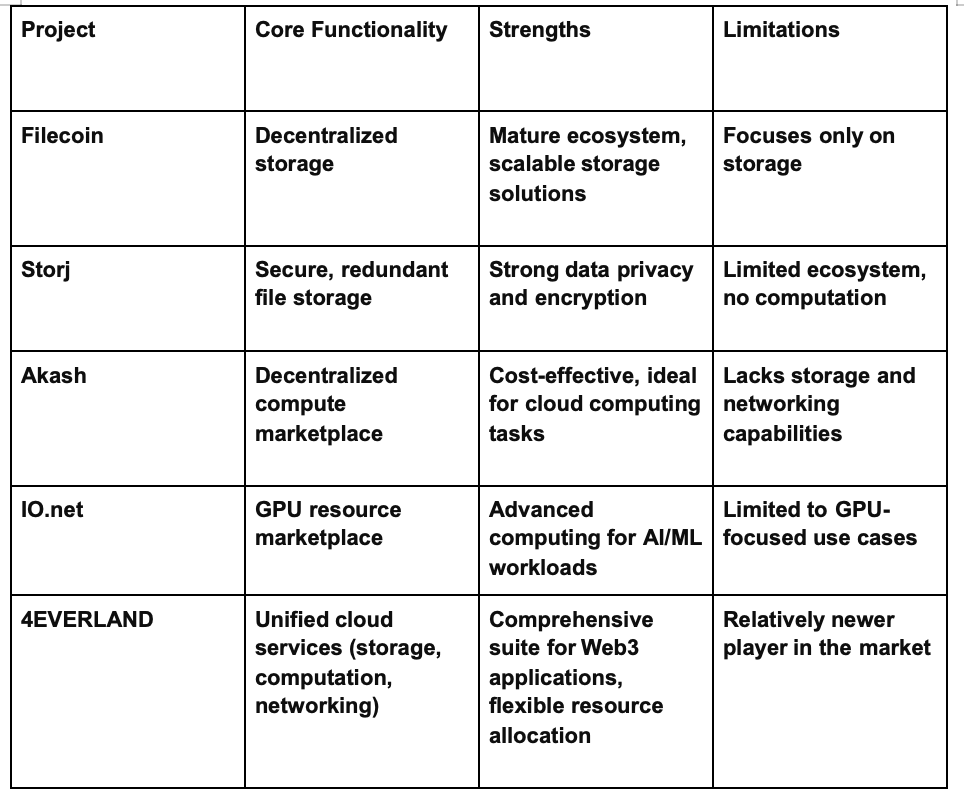
2. 4EVERLAND Ecosystem
The success of 4EVERLAND is closely tied to its extensive ecosystem partnerships. In less than four years, 4EVERLAND has made remarkable progress in ecosystem development, including deep collaborations with numerous decentralized protocols and blockchain projects, covering the following industry leaders:
-
Blockchain Infrastructure: BNB Chain, Polygon, Arbitrum, zkSync, Solana, etc.
-
Decentralized Storage: BNB Greenfield, IPFS, Arweave, Dfinity
-
Web3 Applications: Snapshot Labs, Mdex, etc.
-
DeFi: Uniswap, SushiSwap, Linear Finance, Venus Protocol, etc.
These partners (50+ core partners) provide 4EVERLAND with a solid foundation, enabling it to support a wide range of user scenarios. In addition, thousands of ecosystem collaborators are injecting strong momentum into its ecosystem development.
Moreover, the DApps deployed on 4EVERLAND span various industries, including DeFi, GameFi, RaaS, NFTs, and SocialFi.
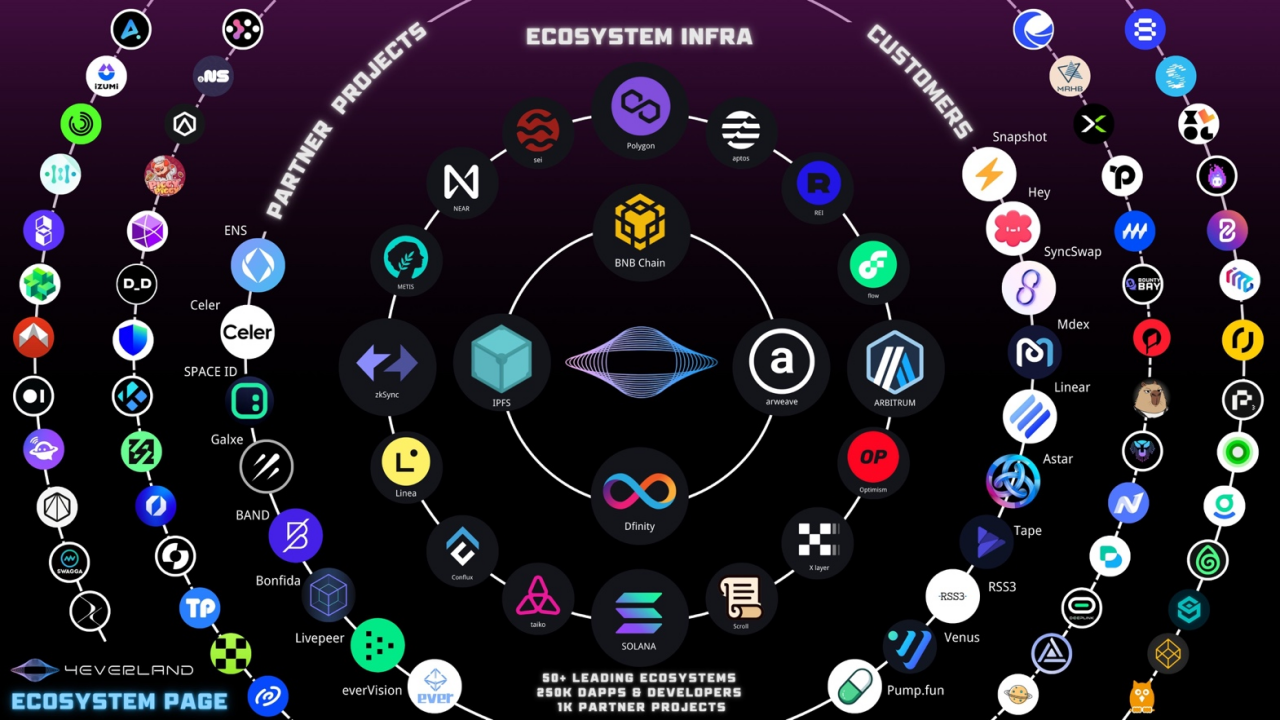
2.1 DeFi Track
4EVERLAND provides IPFS front-end gateway support for numerous well-known DeFi protocols. By deploying the front-end on a distributed storage network, it not only enhances the censorship resistance of the front-end but also solves potential access restrictions and single-point failure issues faced by traditional centralized deployments. At the same time, the distributed gateway technology of 4EVERLAND significantly improves loading efficiency and the stability of global user access.
This support has become an important aid for enhancing infrastructure in the DeFi space, providing technical support for more decentralized protocols and promoting the continued development of the Web3 ecosystem.
2.2 GameFi Track
In the GameFi sector, 4EVERLAND provides storage and hosting services for Web3 games. Many game projects are part of the 4EVERLAND ecosystem, and here are a few examples:
2.2.1 Owlando
Project Overview: Owlando is an innovative cross-platform UGC social game metaverse. In today’s gaming ecosystem, user creativity is often overlooked and underappreciated. Owlando challenges this norm by integrating Non-Fungible Tokens (NFTs) to protect users’ in-game creations and enabling them to monetize their ideas. This process creates a positive-sum game where the platform accumulates rich content, while players can express their creativity and directly benefit from it. Owlando placed third in the Web3 Innovation Competition organized by BeWater.
X: @Owlando_OFCL
2.2.2 Tabi
Project Overview: Tabi (formerly known as Treasureland) is a platform based on the BNB Chain that allows users to trade NFTs and participate in launchpads. It also converts on-chain activities into "experience points," which can be used to earn future airdrop rewards. The platform includes an aggregated blockchain gaming and entertainment platform. Investors include Hashkey Capital, YouBi Capital, etc.
X: @Tabichain
2.3 Other Ecosystem Cooperation Cases
2.3.1 Snapshot
Snapshot is a widely used voting platform for Decentralized Autonomous Organizations (DAOs), relying on secure and efficient storage solutions to store proposals and voting records. 4EVERLAND provides storage services to Snapshot, achieving the following advantages:
-
Simplified Development Process: 4EVERLAND is compatible with AWS S3 APIs, allowing the Snapshot team to integrate its storage service quickly without complex development work.
-
Multi-Protocol Support: Through a unified API, 4EVERLAND supports both IPFS and Arweave storage protocols, offering flexible decentralized storage choices that meet Snapshot's needs for data durability and accessibility.
-
Efficient Storage Performance: 4EVERLAND provides efficient, low-latency storage services with an average response time of less than 100 milliseconds, ensuring a smooth experience for Snapshot users during voting and proposals.
-
Data Integrity and Long-Term Preservation: By leveraging IPFS's content-addressing features and Arweave's permanent storage capabilities, 4EVERLAND ensures the integrity and long-term preservation of Snapshot data, enhancing platform reliability.
2.3.2 RSS3
RSS3 is a decentralized content and social protocol aimed at building a transparent, decentralized, and modular ecosystem. By using 4EVERLAND as its IPFS provider, RSS3 achieves:
-
Decentralized Storage: Utilizing 4EVERLAND's IPFS service ensures decentralized storage and access of data.
-
Ecosystem Integration: The partnership with 4EVERLAND reflects the practice of decentralized and modular principles.
-
Demonstrating 4EVERLAND's Capability: This collaboration highlights 4EVERLAND's ability to support decentralized applications and services.
2.3.3 Liquity
Liquity is a decentralized lending protocol that allows users to borrow the stablecoin LUSD using Ethereum as collateral. To ensure high availability and censorship resistance of its front-end, Liquity collaborates with 4EVERLAND to deploy its front-end on a decentralized network. Through 4EVERLAND's global acceleration and distributed storage, Liquity users can access its services quickly and securely from different regions.
2.3.4 Lenster
Lenster is a decentralized social media platform based on the Lens Protocol, aiming to provide privacy protection and data sovereignty for users. To implement distributed storage and management of its data, Lenster integrates 4EVERLAND's decentralized storage service, Bucket, to store application data on the IPFS network.
Through 4EVERLAND's globally distributed IPFS nodes, Lenster's data achieves high availability and global acceleration. Additionally, 4EVERLAND serves as Lenster's IPFS pinning service provider, ensuring the data's permanence and reliability. This collaboration allows Lenster to offer a more stable and efficient decentralized social experience.
2.3.5 SyncSwap
SyncSwap is a decentralized exchange based on zkSync, offering fast and low-cost trading services. 4EVERLAND collaborates with SyncSwap to achieve decentralized front-end hosting, enhancing SyncSwap's development within the zkSync ecosystem. By adopting 4EVERLAND Hosting, SyncSwap can deploy its front-end on a decentralized storage network, such as IPFS, Arweave, and ICP. This deployment method ensures high availability and censorship resistance of the front-end, improving user experience and system security. Furthermore, 4EVERLAND's automated build and deployment tools allow the SyncSwap team to manage and update its front-end applications more efficiently. This collaboration demonstrates the potential of decentralized technologies in practical applications and provides valuable insights for other blockchain projects.
3. Highlights Summary
The decentralized storage technology has evolved through multiple iterations and innovations, from Storj to Filecoin, Arweave, and the IPFS protocol that supports its operation. Despite these developments, centralized storage still occupies the majority of the market share due to its mature product systems and smooth user experience. Decentralized solutions like Filecoin and Arweave face their own limitations: Filecoin's programmability still needs improvement, and its permanent storage capabilities are constrained; Arweave, which emphasizes "permanent storage," faces challenges in adoption due to its relatively high costs.
Similar challenges also exist in the decentralized cloud computing field. First, scalability is an issue, as distributed computing resources struggle to meet high concurrency and large-scale computing demands. Second, there are cost concerns: although decentralization can reduce infrastructure costs, the complexity of node distribution and resource scheduling increases operational costs. Additionally, latency and performance optimization remain significant challenges.
These issues highlight the current shortcomings in the industry while also providing important directions for technological optimization and model innovation. 4EVERLAND integrates decentralized front-end hosting, decentralized storage, and global acceleration gateways, combining the core capabilities of storage, computing, and networking to offer efficient and reliable computing solutions. With its unique architecture and deep optimization of developer experience, 4EVERLAND stands out from other platforms in the market. As a distributed cloud platform focused on Web3 services, 4EVERLAND’s strategic layout and technical implementation not only emphasize the core spirit of decentralization but also cleverly balance user experience and cost-effectiveness. Here are some of our key perspectives:
1. A New Paradigm of Multifunctional Service Beyond a Single Function 4EVERLAND’s advantage lies in its construction of a multifunctional distributed cloud ecosystem that covers the entire lifecycle of DApp development, from storage to computing. Platforms like io.net and Akash focus mainly on decentralized computing capabilities in a single domain and perform well in the DePIN market but often lack comprehensive functions like storage and network acceleration. In contrast, Filecoin, Arweave, and other single-storage services, while dominating the decentralized storage space, cannot offer full cloud service support. 4EVERLAND, through its integration of computing, storage, and network acceleration, has created a Web3-like distributed AWS. Its unified API design allows developers to deploy projects quickly without mastering underlying blockchain technologies, achieving superior user-friendliness and functionality.
2. Dual Breakthrough in Technical Implementation and User Experience Unlike Akash, which emphasizes the efficiency of the computing power auction market, or io.net's GPU time-lock proof, 4EVERLAND focuses on optimizing the entire chain from technology to user experience. The platform’s user interface and deployment tools lower the threshold, allowing non-technical users to easily deploy distributed applications. This design, which is closer to user needs, makes 4EVERLAND the first choice for Web3 startups and individual developers. Additionally, it emphasizes the balance between performance and economics: through a distributed CDN network and intelligent routing, 4EVERLAND delivers performance close to traditional cloud services while significantly reducing costs—a rare optimization in decentralized platforms.
3. Privacy Protection and Data Sovereignty The core value of decentralized technology is data sovereignty, and 4EVERLAND exemplifies this principle. Users not only own their data but can ensure its distribution globally and protect it from centralized attacks through decentralized architecture. Compared to io.net's time-based leasing model, 4EVERLAND’s sharded storage solution shines in data integrity and availability. Furthermore, 4EVERLAND upholds privacy-first design principles, with a no-KYC mechanism and a fully transparent fee management system, allowing users to use services in a completely anonymous environment. This design is particularly crucial for privacy-sensitive industries such as finance and healthcare.
4. Incentive Models and Community Governance Integration Tokenomics Value Capture: 4EVERLAND emphasizes the multifunctionality of its tokens, and its carefully constructed dual-token economy strikes a sustainable balance between growth and stability. We believe 4EVERLAND will become an important bridge to the future decentralized internet, enabling developers, users, and community participants to cooperate in building a prosperous and scalable Web3 ecosystem.
5. Global Layout and High Adaptability 4EVERLAND has deployed distributed nodes globally to provide users with high-speed, stable content delivery services. Its intelligent node routing technology enhances performance while reducing network latency. It also possesses future-proof scalability: 4EVERLAND's technology stack is better suited for the long-term development needs of the Web3 world, including decentralized domain names, on-chain storage, and other future applications.
As the decentralized storage field rapidly develops, 4EVERLAND's synergistic effect is driving the construction of the next generation of Web3 infrastructure. Its deep integration, multi-chain support, and user-friendly design not only expand the application scenarios of decentralized storage but also inject strong innovative momentum into the entire ecosystem. However, this field is still full of uncertainties. Can decentralized storage fully replace centralized solutions in the future? How will the market balance user experience, costs, and privacy? Will the competitive landscape within ecosystems intensify, or will greater synergies be achieved through collaboration? These questions remain to be explored and answered by the industry.
In this ever-evolving race, 4EVERLAND’s continuous technological iteration and ecosystem expansion will undoubtedly set more industry benchmarks and provide valuable reference directions for other projects. The game for data sovereignty and the future of storage may just be beginning.